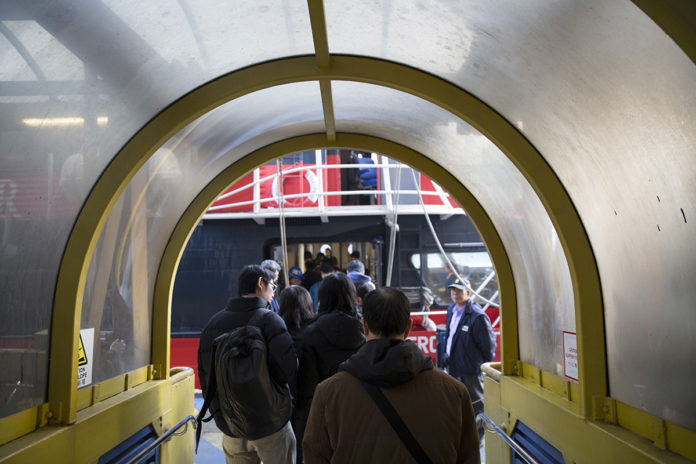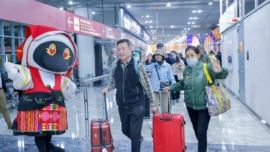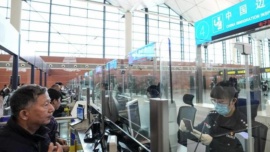There will always be those who choose to come by boat, especially if it is more convenient. But the numbers for 2019 show a sharp drop in passengers who opted for ferries.
MB November 2020 Special Report | Getting in and out
Although the numbers for 2019 are also marked by the political and social situation experienced in the last semester in Hong Kong, there is no doubt that the opening of the Hong Kong-Zhuhai-Macau Bridge (HZMB) has translated into a paradigm shift, with a sharp reduction in ferry traffic between the two special regions.
“The Group’s transportation division faced formidable challenges in 2019. With the opening of the HZMB in late 2018, its full effect on regional travel dynamics began to play out in the first half of 2019. Tour groups have shifted away from ferry to land routes, as a result, TurboJET has seen a downturn in passenger volumes,” state the last Shun Tak Holdings financial report.
“The HZMB opens up land transportation to Macau which directly competes with the Group’s Hong Kong-Macau ferry service. (…) Revenue from the Group’s ferry traffic has been substantially reduced after the bridge,” the report reads.
Last year, the “TurboJET” routes between Macau and Hong Kong transported 7.9 million passengers, which represented an annual drop of 39 per cent. As a result, the company posted losses of HKD 122 million. This fall contributed to Shun Tak Holdings registering a 26 per cent decline to HKD 3.45 billion in profits, compared to 2018.
“42.7 per cent of visitors indicated that they will reduce the use of marine terminals due to the opening of the bridge” – MGTO


The other ferry operator between Macau and Hong Kong, Cotai Water Jet, also saw passengers drop, although this deal is an accessory for Sands China.
Even so, “convention, ferry, retail, and other revenues for the year ended December 31, 2019 were USD 230 million, a decrease of 24.3 per cent, compared to USD 304 million for the year ended December 31, 2018. The decrease was primarily driven by decreased business volume in ferry operation impacted by the HZMB opening in October 2018 and the on-going situation in Hong Kong since June 2019,” shows the gambling concessionaire report.
Overall, passenger traffic between Macau and Hong Kong decreased by almost 40 per cent in 2019.

Once it is necessary to go back at least 10 years to find numbers similar to those of June last year (without the impact of social unrest and Covid uprising, therefore), it is necessary to take measures to mitigate the impacts.
Cotai Water Jet removed six daily Macau-Hong Kong ferry routes last year. This cancellation follows another cut of three daily sailings between Taipa and Sheung Wan.
On the TurboJET side, concrete measures are not yet known.
On the one hand, the company was slow to admit the impact of the bridge; on the other hand, any plans were frozen with the suspension of connections because of the pandemic. Still, at the end of last year, Pansy Ho announced that Shun Tak is enforcing adjustments to deal with expected drop in ferry travel. And earlier this year it was learned that the company had notified employees that it will reduce the wages of workers who currently receive salaries above HKD 10,000 per month.
Although these are times of uncertainty, this seems to be a trend that is here to stay.
A few weeks before the pandemic, the Macau Government Tourism Office (MGTO) released the results of a study on the “Impact of the opening of the Hong Kong-Zhuhai-Macau Bridge on the tourism industry”, which shows that 42.7 per cent of visitors indicated that they will reduce the use of marine terminals due to the opening of the bridge. The pattern of land and sea travel by visitors to Hong Kong, in particular, seems to be changed significantly, with 60.6 per cent indicating that they will reduce the use of terminals due to the opening of the HZMB.
The port
In Macau, maritime transport is reduced to ferries. There was never a market or plans for other trips, like cruises. Creating a cruise terminal has never been considered.
The only attempt was to promote yacht travel, through the pilot project Zhongshan-Macau Free Yacht Scheme, launched at the end of 2016.
The results are disappointing so far: the last yacht to arrive in Macau was in 2018. The only yacht in the past three years. Costs and bureaucracy can explain the failure.
Any other plans clash with the limitations of the port of Ká-Hó.
Some years ago, journalists asked the president of the Macau Convention and Exhibition Association, Eva Lou, what were the difficulties that the local MICE sector had; she replied in this way: “In addition to the lack of direct international flights, the logistics component is affected by the fact that Macau does not have deep waters. Macau is not a logistics center, we have no cargo port, so you will not believe it but shipping a container from Hong Kong to Macau is more expensive than if it is sent to Los Angeles. It is ridiculous.”
























